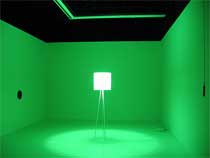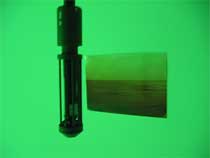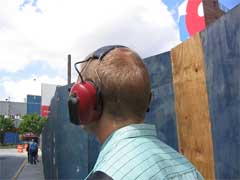A last show i didn’t want to miss while in New York last week was Invisible Geographies: New Sound Art from Germany, an exhibition about the “physical” topography of sound at the Kitchen.
There was one of the most interesting sound works i’ve seen all over Europe this year: g-Pod, by Jens Brand, the mobile version of his G-Player (Global player) installation. Select one of the 400 satellites on the ipod menu and the device will analyse the topographical profile of the region that satellite is flying over at the moment and translate it into sound. Quite eerie and surprisingly addictive.


Jan-Peter Sonntag’s amazing installation was another hit. You enter a room bathed in beautiful green light. The long sound waves generated by the system can be slightly felt through your body but not heard. The green light references the “green ray” optical phenomena, a flash of light that sometimes appears on the ocean’s horizon at sunset.
A few months ago during Sonambiente, i had discovered another work by Sonntag: Modern Minimal Disco. You step onto a steel pedestal located right in the middle of the exhibition space and don headphones. The sub-frequency parts of the accellerating pulse, perceptible only as shock waves, are directly transmitted as vibrations via special headphones and pedestals to the listener. The listener on the pedestal is presented as the central focus point by phto shoot-like bright lights and a wall sized mirror. S/he becomes thus part of the work and as such is her/himself exhibited while observing the work (images.)
 The Kitchen was featuring another work i’d have liked to experience (but had no time left for that). Christina Kubisch‘s Electrical Walks customized for New York. The public is given a map of particular destinations in Chelsea and special magnetic headphones that reveal the sound of electrical currents that exist throughout the city but are normally imperceptible.
The Kitchen was featuring another work i’d have liked to experience (but had no time left for that). Christina Kubisch‘s Electrical Walks customized for New York. The public is given a map of particular destinations in Chelsea and special magnetic headphones that reveal the sound of electrical currents that exist throughout the city but are normally imperceptible.
The headphones detect sound emitted by electro-magnetic fields generated by lighting systems, electronic security systems, power sources, wireless communication systems, surveillance cameras, mobile phones, etc. “The magnetic component of these fields is picked up by the sensor coils in the headphones,” explains the artist. “and, after amplification, these signals are made audible by little speaker systems in the headphones. So if there’s an electromagnetic field (say, an underground cable) and another one nearby (say, the headphones), the fields pick up each other. The sound jumps through the air from one to the other.”
Image of the walks found on Ryan Griffis‘ flickr images.
Invisible Geographies: New Sound Art from Germany runs until October 14, 2006, 512 West 19th Street, New York. My flickr images. Another review of the show by Lauren Cornell, via Networked_performance.
